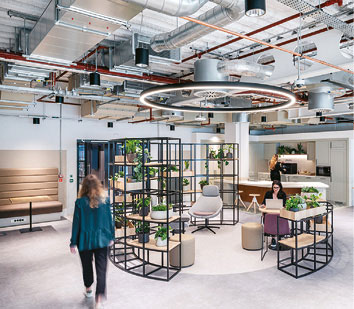Despite the push for more ‘in person’ working styles, many office spaces still struggle with persistent and overbearing ‘noise’. Ben Hancock, MD at Oscar Acoustics, explains how acoustic sound sprays can help manage the next phase of office working
A large proportion of the UK workforce are well accustomed to hybrid working – spending their time between the office, where they interact with colleagues and the quiet surroundings of their home. But views around hybrid working are changing with more employers seeing time in the office as a way to improve productivity.
The trend, which is linked to a boost in productivity, is catching on and for the first time since the pandemic, people are spending more time in the office than they are at home. A study by recruitment giant, Hays, of almost 15,000 white collar professionals found that 43 per cent now work exclusively in the office compared to 39 per cent who are using a hybrid model(i).
Yet, as we’ve seen in recent times, working styles are constantly evolving, and while employers may insist of a need for more ‘face time’ from staff – this is still interspersed with people in the office communicating with those working remotely.
WORKPLACE HIVE
The shift back to office work is placing a greater emphasis on the suitability of working environments – extra personnel are once again turning offices into a hive of activity, bringing with them spiralling noise levels. Increased demands are also on facilities managers, whose job it is to ensure safe and comfortable surroundings, and who will be expected to manage this ongoing issue.
The problem is that much of the UK’s office stock is ill-equipped to deal with the cacophony caused by everyday workers. Our own studies(ii) show this to be the case. For example, hybrid workers in the finance sector blame ‘poor quality work’ and a drop in job performance on excess office noise.
Nearly three quarters (74 per cent) believe that they can work better at home than in the office “because it was easier to focus”. More than one in four (26 per cent) have been pushed to work outside of contracted hours, to make up for lost time due to a lack of focus. These are telling stats and reflective of similar findings over the past three years.
So, what can FMs do to stem the problem before workforces are back at full capacity? One solution is to manage and reduce office noise through the right acoustic solution – primarily the use of premium acoustic sprays. The idea of using headphones or noise screens only goes so far and affects the flow of communications between teams, making it unworkable. It’s only by absorbing sound energy rather than reflecting it, that FMs can make a real difference.
SPRAY SOLUTIONS
The beauty of premium acoustic sprays is not just their effectiveness but their versatility. They can be applied to nearly all substrates, including metal, wood or concrete and on the walls or ceilings, allowing them to work with the contours of a space without impacting the design scheme. To the eye, passers-by won’t see any difference – they work seamlessly but make all the difference on the ears.
These types of sprays also complement the growing use of dividing structures and pods used for collaboration and brainstorming. They allow complete flexibility with Cat A and Cat B without disrupting the acoustic spray finish on the ceiling above.
However, they do more than just turn down the volume; premium acoustic sprays also contribute towards many sustainable design and health certification systems, including BREEAM, SKA, Living Building Challenge and adds up to 17 points towards the LEED (Leadership in Energy and Environmental Design) rating of a project. They’re also GREENGUARD Gold Certified, important given the recent focus on air quality, so it’s important to choose sprays that have been third-party tested.
 For FMs, fire safety is always paramount, and not all products are created equal. It’s imperative that acoustic sprays go above and beyond Approved Document B fire requirement (Class 0 to BS476 & B-s1, d0 fire rating) as they produce little to no smoke and absolutely no droplets, which can assist in the safe escape of office workers.
For FMs, fire safety is always paramount, and not all products are created equal. It’s imperative that acoustic sprays go above and beyond Approved Document B fire requirement (Class 0 to BS476 & B-s1, d0 fire rating) as they produce little to no smoke and absolutely no droplets, which can assist in the safe escape of office workers.
It’s obvious that the changing dynamics around our workspaces will have a big impact on the levels of noise workers are exposed to. Those keen to nip the issue in the bud will do well to think about office acoustics, which has a major influence on productivity levels but also staff health and happiness. As the world of work turns yet another corner, FMs can continue to stay one step ahead, and it starts with giving the right care and attention to office acoustics. Your office productivity may depend on it.





